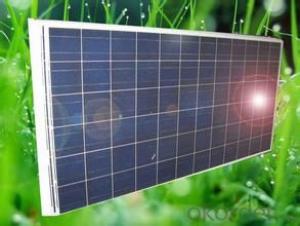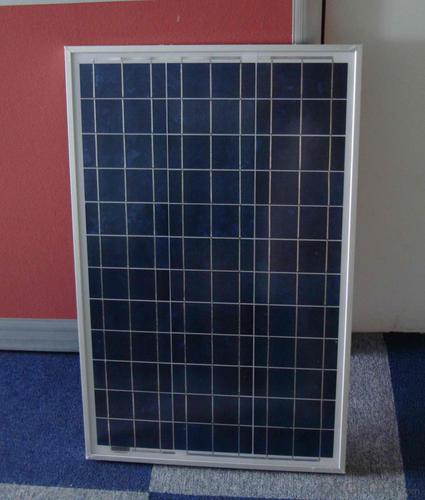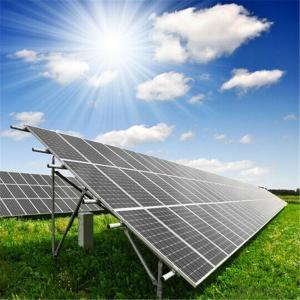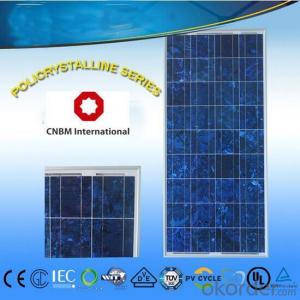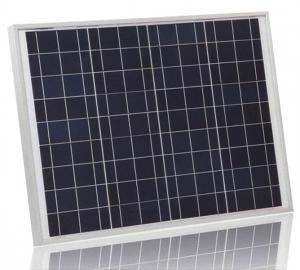West Facing 210 to 250wp Polycrystalline Solar Panels, Solar Module, Solar LED Module
- Loading Port:
- China main port
- Payment Terms:
- TT OR LC
- Min Order Qty:
- 1 pc
- Supply Capability:
- 100000000 pc/month
OKorder Service Pledge
OKorder Financial Service
You Might Also Like
Quick Details
| Place of Origin: | Guangdong China (Mainland) | Brand Name: | HUAYU | Model Number: | HYS-120WM36V |
| Material: | Monocrystalline Silicon | Size: | 1196*669*35mm | Number of Cells: | 72 |
| Max. Power: | 120W | Certification: | ISO/CE/TUV/UL | Application: | Home |
| Warranty: | 20 years limited warranty on power | Solar Cell: | A-grade,high efficiency | Frame: | Aluminium Alloy |
| Glass: | Toughened Glass | EVA: | Highly Adhesive | Backsheet: | TPT/TPE(Block Humidity and Oxy Effectively ) |
| Specification: | Normal |
Packaging & Delivery
| Packaging Detail: | wood case and pallet |
| Delivery Detail: | 10 days |
Specifications
solar module 100wp
High Quality Monocrystalline solar Panel 120W/36V,also provide solar power system
The Best New photovoltaic solar Panels mono , solar system,120W/36V, solar photovoltaic ,solar system,iso certified companies
Principle of solar system

A grade high efficiency solar cells.
15 years limited warranty on material and workmanship
20 years limited warranty onpower
Characteristics
Modules: HYS120WM-36V
Cell: Monocrystalline solar cells (156*61mm)
NO. of cell: 72(4*18)
Maximum power at STC(Pm): 120W
Open circuit voltage(Voc): 42.48V
Optimum operating voltage(Vmp): 35.2V
Short circuit current(Isc): 3.77A
Optimum operating current(Imp): 3.40A
Dimension of module: 1196*669*35mm
Weight: 10kg
Certificate: ISO/CE/TUV/UL
STC:Irradiance 1000W/m2 ,Module temperature 25°C,AM=1.5 Blueprint of the module
Limits
Operating temperature: (-40 to +85°C)
Maximum System voltage: 1000VDC
Temperature and Coefficients
NOCT: (48±2)°C
Current temperature coefficients: (0.06±0.01)%/K
Voltage temperature coefficients: (-155±10)mV/K
Voltage temperature coefficients: (-0.5±0.05)%/K
NOCT:Nominal operation Temperature
Performance Warranty
15 years limited warranty on material and workmanship
20 years limited warranty on power output
Output
Type of terminal: Junction box
Cable: LAPP(4.0mm2)
Asymmetrical lengths: 900mm
The publication summarises warranty and specifications which are subject to change without notice.
- Q: What is the difference b/w them which one is better .
- Guide okorder /
- Q: Can solar panels be installed on a data center or technology facility?
- Yes, solar panels can be installed on a data center or technology facility. In fact, many data centers and technology facilities around the world have already adopted solar energy as a means of powering their operations. Solar panels can be installed on rooftops, parking lots, or nearby land to generate clean and renewable electricity, reducing the facility's reliance on traditional power sources and lowering its carbon footprint. This not only helps in reducing energy costs but also contributes to a more sustainable and environmentally friendly operation.
- Q: How much money can you save by using solar panels?
- The amount of money you can save by using solar panels depends on various factors such as the size of your solar system, your energy usage, location, and the cost of electricity in your area. On average, homeowners can save anywhere from a few hundred dollars to several thousand dollars annually. It's recommended to consult with a solar professional to get a personalized estimate based on your specific circumstances.
- Q: Can solar panels be installed on a shopping mall or retail center?
- Yes, solar panels can be installed on a shopping mall or retail center. In fact, many shopping malls and retail centers around the world have already incorporated solar panels into their infrastructure. This not only helps to reduce energy costs for the businesses operating within the mall but also promotes sustainability and reduces the carbon footprint of the facility.
- Q: Can solar panels be installed on a parking lot or carport?
- Yes, solar panels can be installed on a parking lot or carport. In fact, these locations are ideal for solar panel installations as they provide ample space and can generate clean energy while also providing shade and protection for vehicles. This dual-purpose approach helps maximize the benefits of solar energy and optimizes land usage.
- Q: They have been around long enough to be cheaper. Unless they are made out of a natural material that is rare and hard to find, there is no reason why they should be so expensive. On another note, I think that all low power devices like cell phones and even laptops should have solar panels. Even if it is not enough to fully power the device for a long period of time, it will provide some electricity savings and with millions of people saving a little power adds up.
- materials and process... if they could be built in a sweatshops, by kids, in Malaysia, they'd be cheap and everyone would use them
- Q: I have a solar panel 7.5V .25W 50mah, connect 2 in parallel to power a RC boat. The boat use to run on 6cell battery pack - 7.2V 800Mah.The dc motor requirement based on the provided battery pack, i assume would be 7.2V and rated at (7.2V * .8Amp) = 2.96 Watt.Would two of my solar panels run this DC motor ?are my calculations or understanding correct ?do lend a hand dear ''world''
- solar cells are not rated in mah, they are rated in ma or amps. I'll assume this one is 50mA. Two in parallel will give you 300mA, so that will charge a 800mA-hr battery in 800/300 = 3 hours. Theoretically, in bright sunlight if the array is exactly at right angles to the sun's rays. The problem is, depending on the type of cells, the battery pack will need 8 volts or so to charge, and your solar cells won't deliver that. If the sun is at an angle, you may get only 3-5 volts. so you have to put them in series, so you will get only 50mA out of them, which will charge the battery in 6 hours of bright sunlight. Would two of my solar panels run this DC motor ? If the motor is .8 amps, you need the battery, the arrays are not near enough. Or are you attempting to replace the battery pack with the solar array? Your english makes that difficult to understand. If so, put them in parallel to get the 300mA, but that would run the .8 amp motor very slowly. If you had 2 of the solar panels, it might run at close to full speed if the sun is bright and shining directly on all the panels. But where did you get the .8 amps for the motor? The 800Mah rating of the battery has ZERO to do with the motor current. So the answer above is based on your number, which I suspect is totally wrong. .
- Q: Can solar panels be used in areas with high levels of UV radiation?
- Yes, solar panels can be used in areas with high levels of UV radiation. In fact, they are designed to withstand and harness UV rays from the sun to generate electricity. The materials used in solar panels are specifically chosen to endure high UV exposure, ensuring their efficiency and longevity even in such conditions.
- Q: How do solar panels affect the property's long-term financial viability?
- Solar panels can have a positive impact on a property's long-term financial viability due to various factors. Firstly, solar panels can significantly reduce or eliminate electricity bills, leading to long-term savings on energy costs. Additionally, with the potential to generate excess electricity, property owners can sell the surplus back to the grid, generating additional income. Moreover, solar panels can increase the value of a property, as they are considered a desirable and environmentally-friendly feature. Lastly, with the growing adoption of renewable energy, properties with solar panels are likely to attract more potential buyers or tenants, enhancing the property's marketability and ensuring long-term financial stability.
- Q: i need to know wat the parts of a solar panel are.
- A solar panel is just a collection of solar cells all wired up in parallel and series to provide a useful voltage. Typical solar cells only provide half a volt, maybe less, so usually you put 2 of them together to get a 6v solar panel or 24 of them to get a 2v panel. Solar cells are made in various ways, the most popular are silicon solar cells which are made with a chunk of silicon with a P-N junction in the middle and contacts on either side. When a photon of light comes in, the energy of the photon is converted to electrical energy. Individually, photons contain a tiny amount of energy, but when you have a solar cell in the sunlight, billions and billions of photons hitting it constantly create a useful amount of electrical energy. Solar panels are incredibly simple!
Send your message to us
West Facing 210 to 250wp Polycrystalline Solar Panels, Solar Module, Solar LED Module
- Loading Port:
- China main port
- Payment Terms:
- TT OR LC
- Min Order Qty:
- 1 pc
- Supply Capability:
- 100000000 pc/month
OKorder Service Pledge
OKorder Financial Service
Similar products
Hot products
Hot Searches
Related keywords

